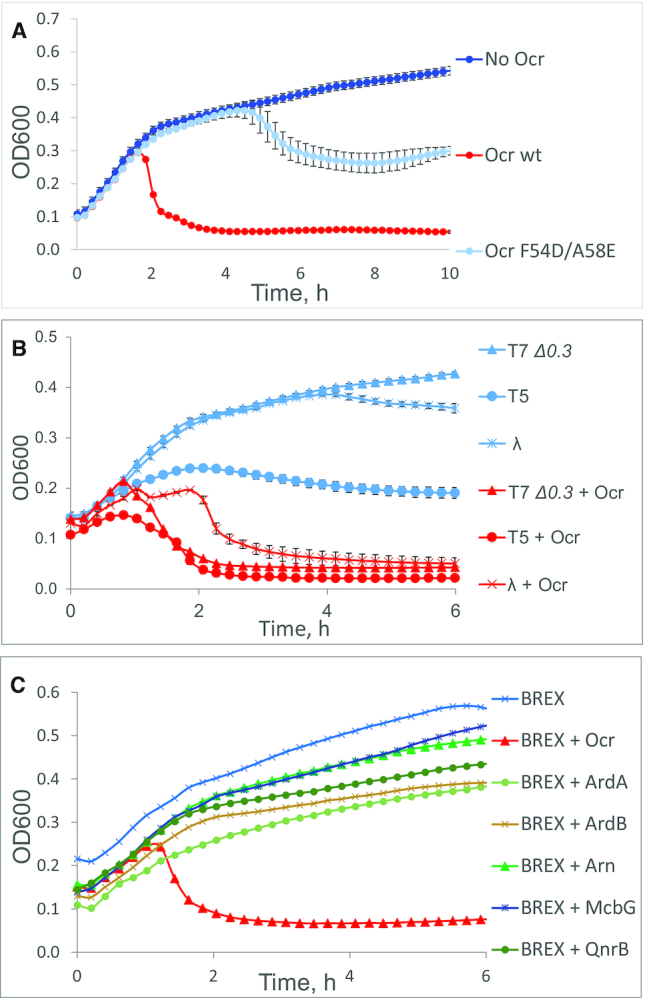Nucleic Acids Research, 2020, 48(10): 5397–5406, https://doi.org/10.1093/nar/gkaa290
In Figure 4C, the authors inadvertently omitted the growth curve for BREX + ArdB.
Figure 4.

Ocr––but not other DNA mimic or antirestriction proteins––is sufficient for shutting off BREX defence by different phages. (A) Growth curves of BREX+ cells overproducing the indicated variants of Ocr infected with T7 Δ0.3 at MOI = 0.001. (B) Growth curves of BREX+ cells overproducing wild-type Ocr infected with the indicated phages at MOI = 0.001 (T7 Δ0.3 and T5) or MOI = 1 (λ cI857). (C) Growth curves of BREX+ cells expressing indicated proteins and infected with T7 Δ0.3 at MOI = 0.001. ArdA: a DNA mimic protein from ColIb-P9 plasmid and an inhibitor of R–M I systems; ArdB: a non DNA mimic inhibitor of RM I systems from pKM101; Arn: a DNA mimic from phage T4, and an inhibitor of RMIV systems; McbG, QnrB: DNA mimic proteins of the pentapeptide repeat proteins family, inhibitors of DNA gyrase. For inducing plasmid-borne genes, cultures were grown in the presence of 13.3 mM Larabinose (Ocr, McbG and QnrB) or 1mMIPTG (ArdA, ArdB and Arn). Phage was added at t = 0. Each growth curve represents the mean optical density and standard deviations values obtained from three independent experiments. Standard deviations are not shown in panel C for the sake of clarity.
A new figure is provided below, and the published article has been updated.
This error does not affect the results or conclusion of the article.
Contributor Information
Artem Isaev, Skolkovo Institute of Science and Technology, Moscow 143028, Russia.
Alena Drobiazko, Skolkovo Institute of Science and Technology, Moscow 143028, Russia.
Nicolas Sierro, Philip Morris International R&D, Philip Morris Products S.A., Neuchatel 2000, Switzerland.
Julia Gordeeva, Skolkovo Institute of Science and Technology, Moscow 143028, Russia.
Ido Yosef, Department of Clinical Microbiology and Immunology, Sackler Faculty of Medicine, Tel Aviv University, Tel Aviv 69978, Israel.
Udi Qimron, Department of Clinical Microbiology and Immunology, Sackler Faculty of Medicine, Tel Aviv University, Tel Aviv 69978, Israel.
Nikolai V Ivanov, Philip Morris International R&D, Philip Morris Products S.A., Neuchatel 2000, Switzerland.
Konstantin Severinov, Skolkovo Institute of Science and Technology, Moscow 143028, Russia; Waksman Institute of Microbiology, Piscataway, NJ 08854, USA; Institute of Gene Biology, Russian Academy of Sciences, Center for Precision Genome Editing and Genetic Technologies for Biomedicine, Institute of Gene Biology, Russian Academy of Sciences, 34/5 Vavilov str., 119334 Moscow, Russia.


